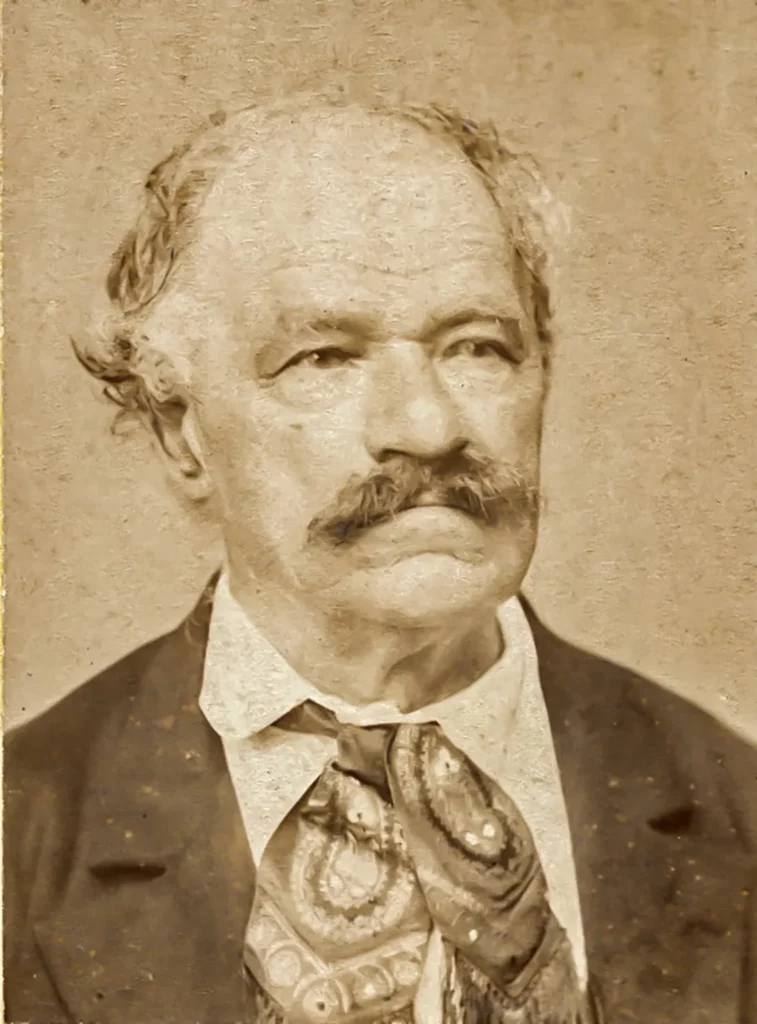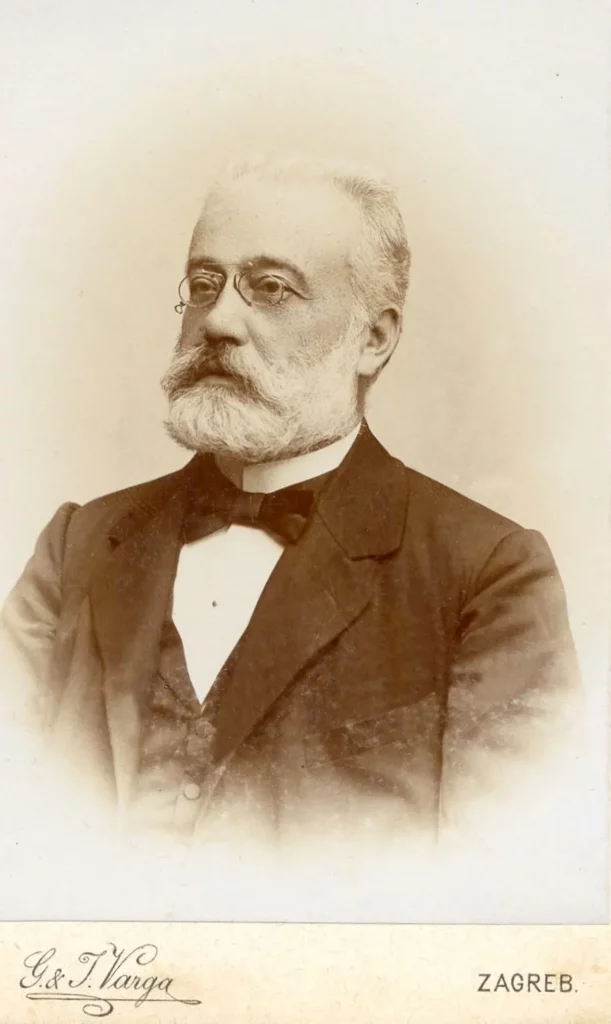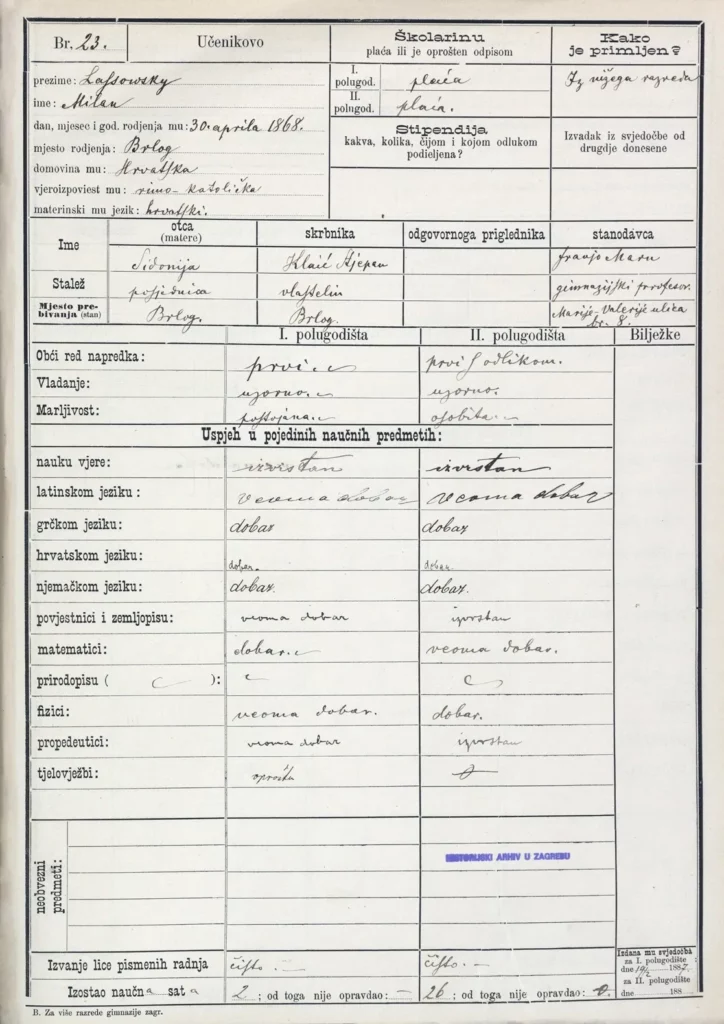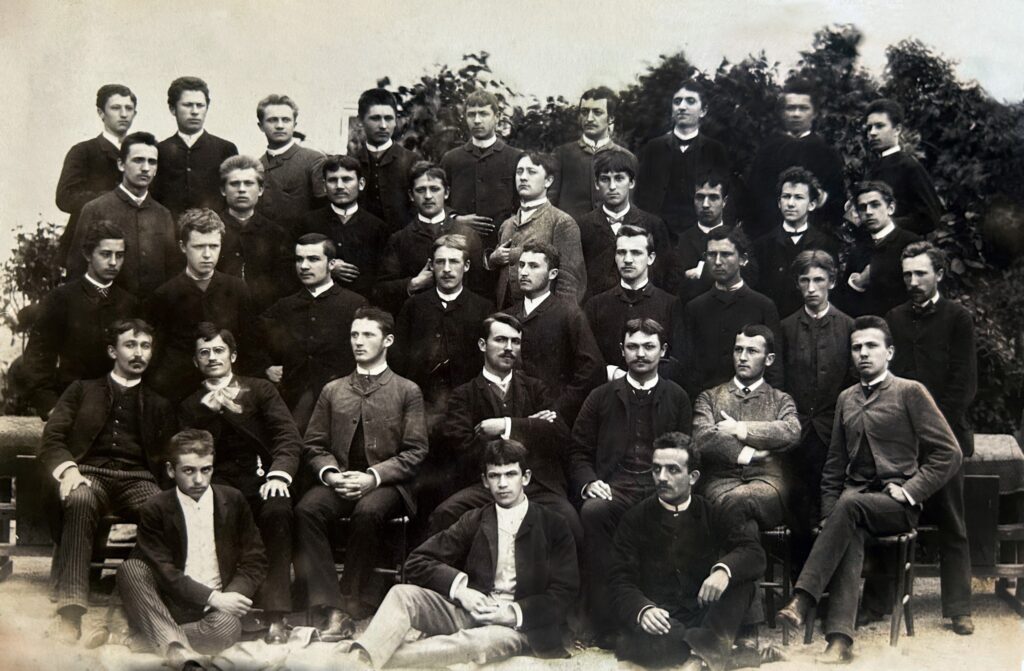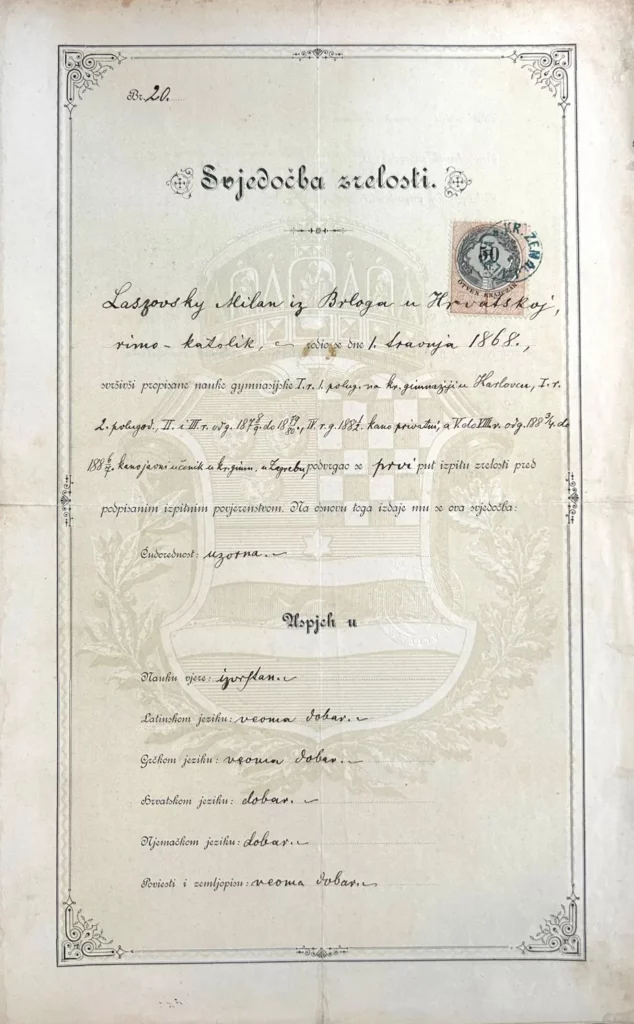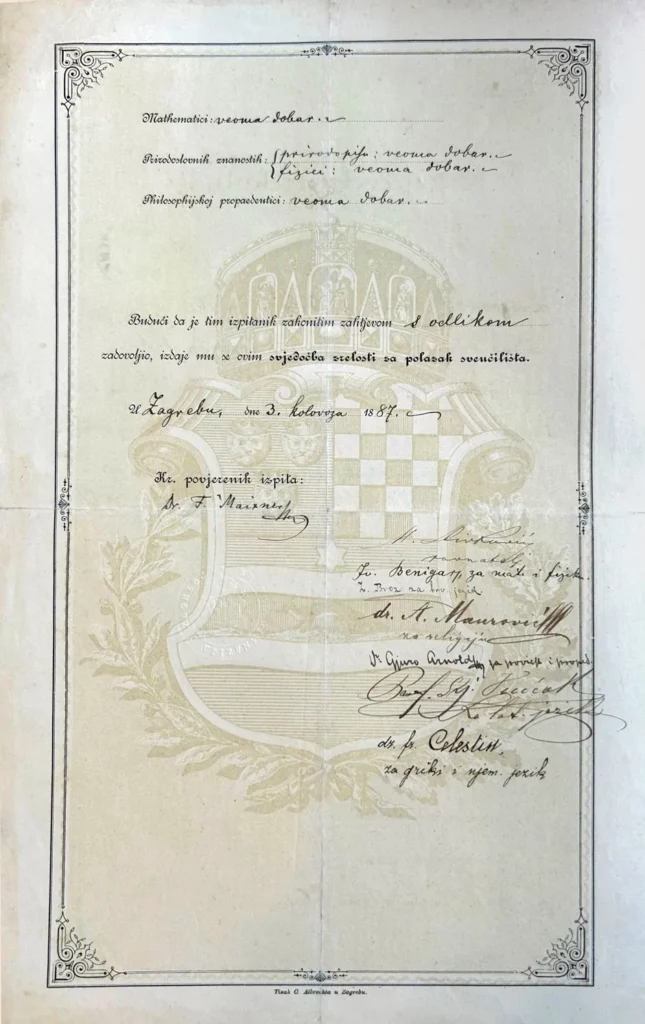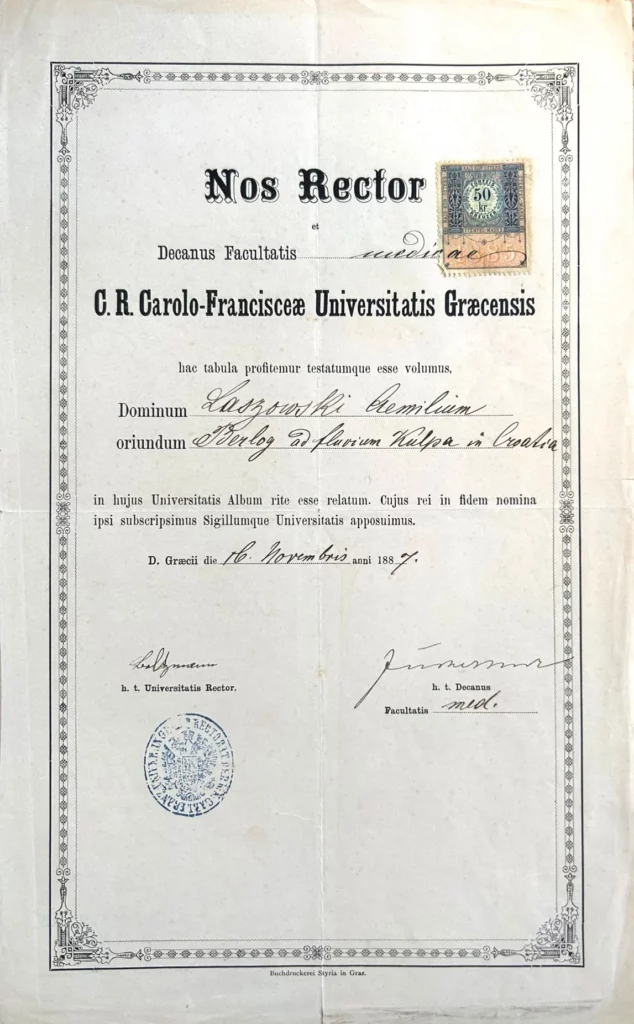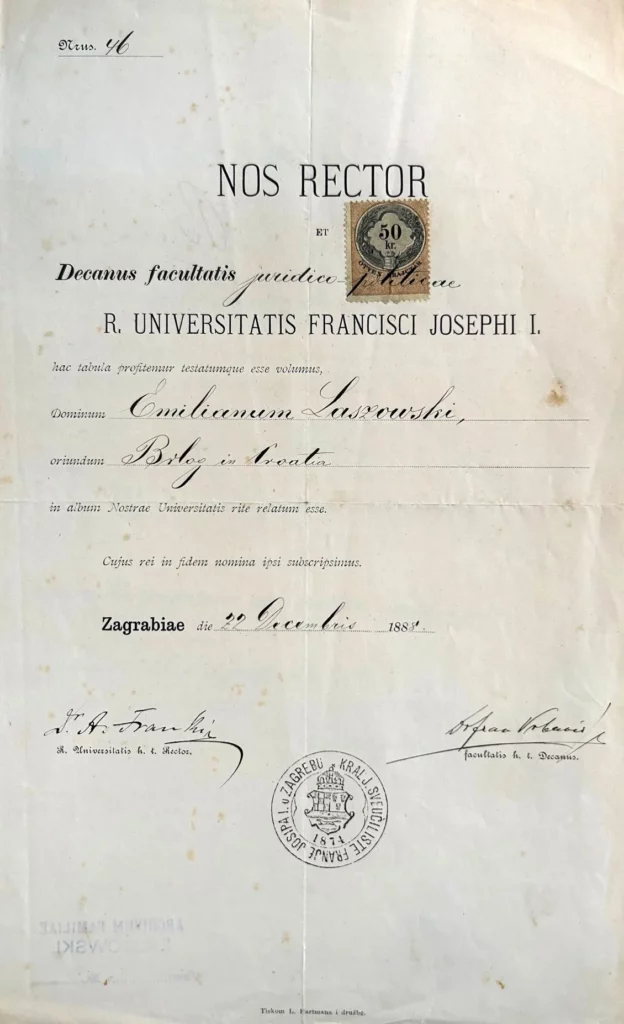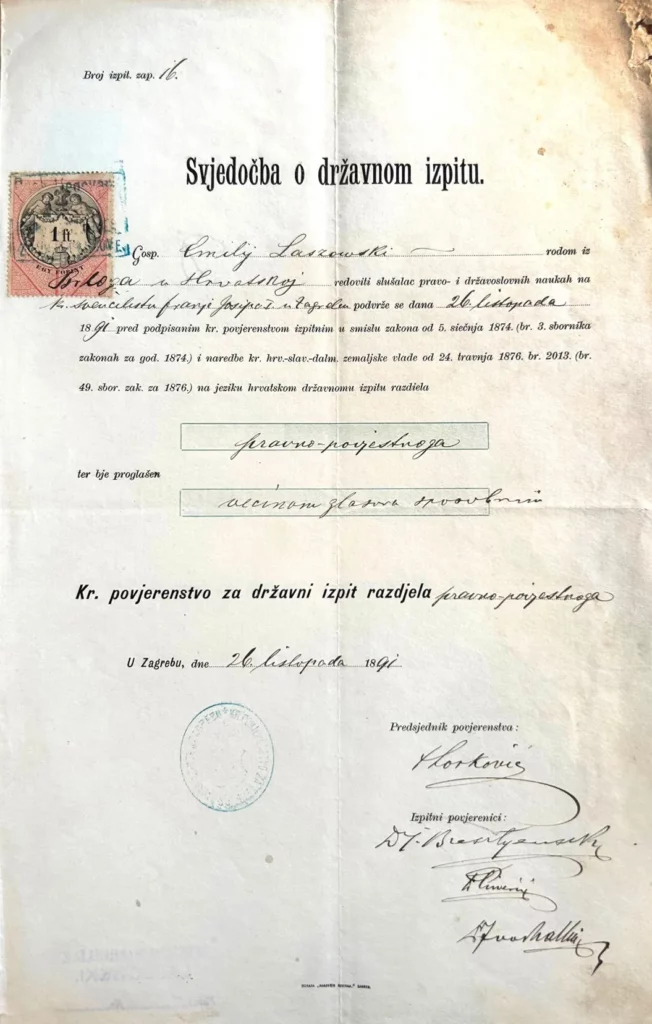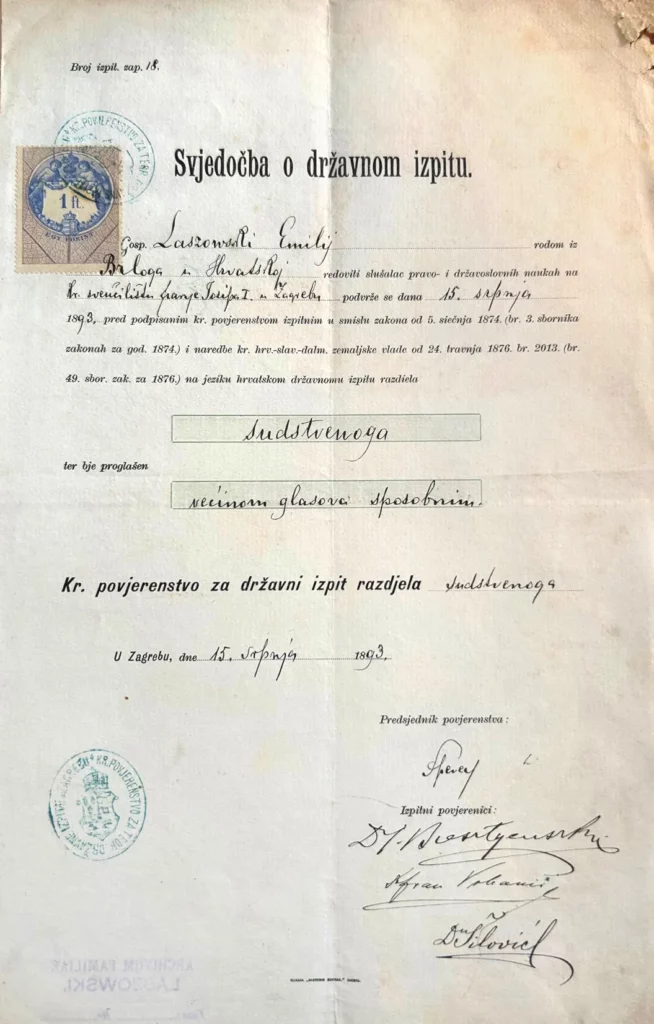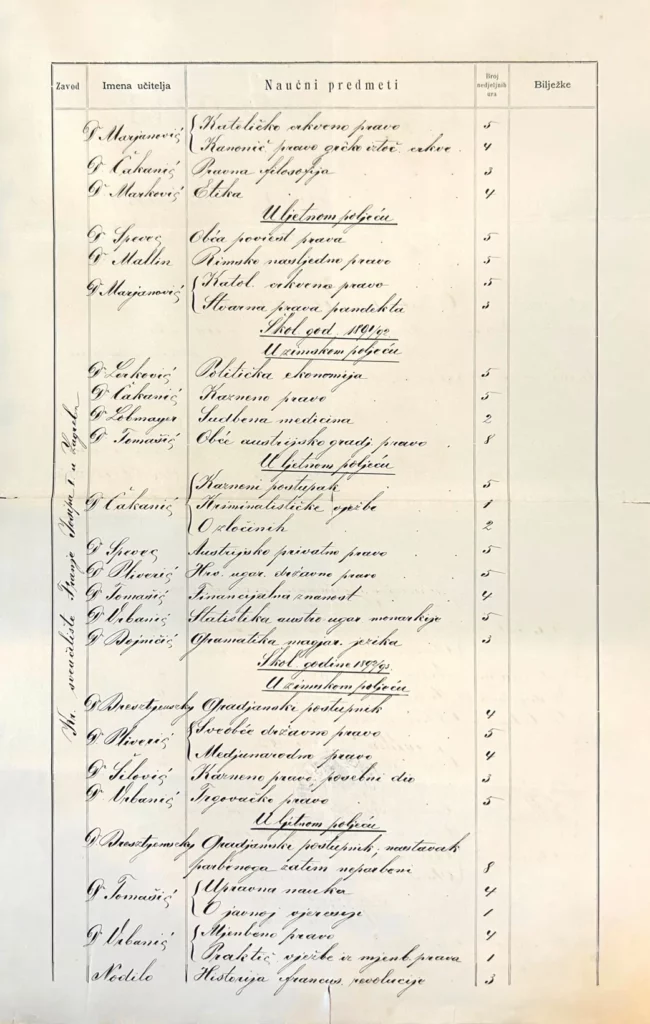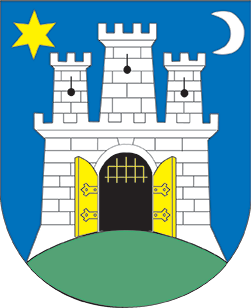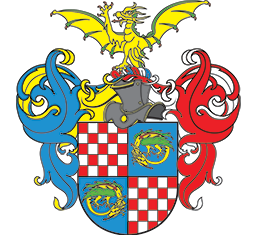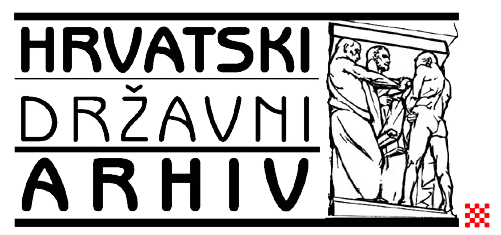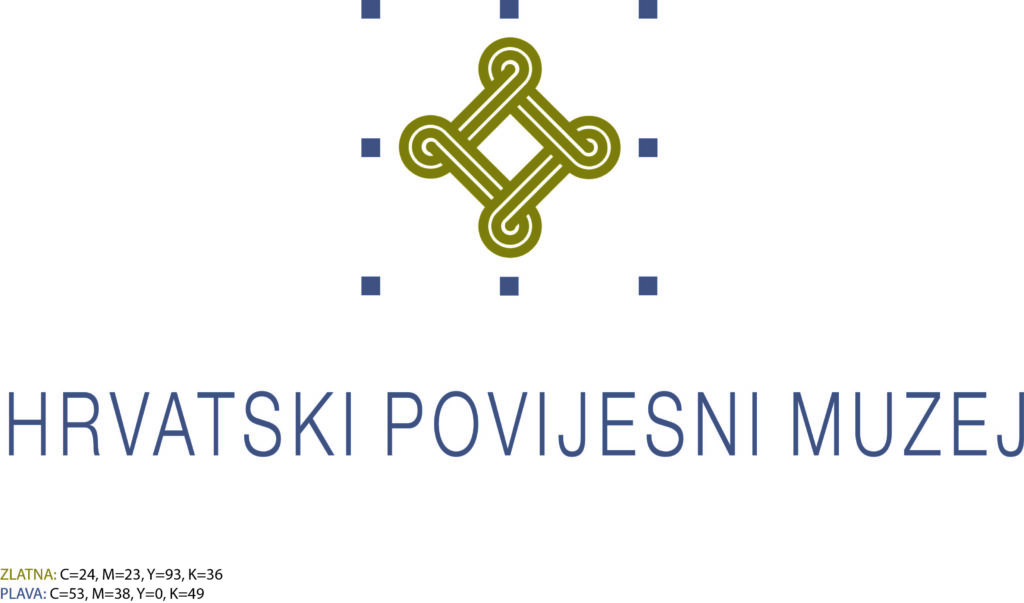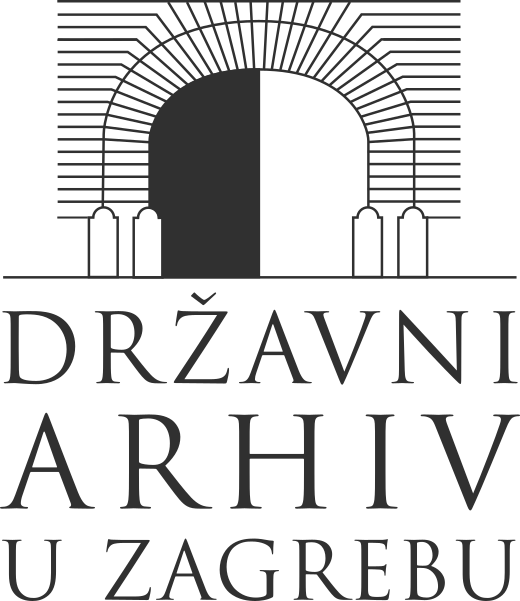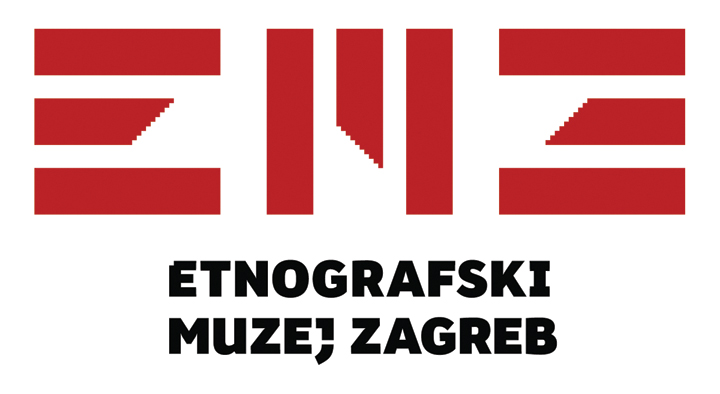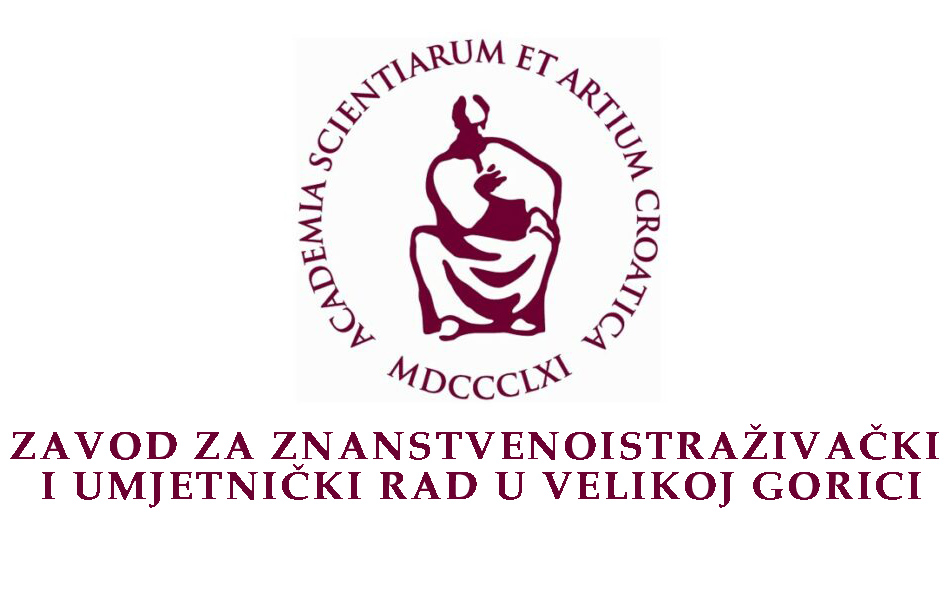2. How and what did I learn?
Every morning, before breakfast, I would go into his room and sit down next to him on the sofa. He would read declensions and conjugations with translations into German
(hic dominus – der Herr; hujus domini – des Hern, etc.) …
From then on, I spoke only Latin with him, and I do not remember it ever being any other way.
Life in Brlog on the river Kupa was marked by a mother’s and grandfather’s attention for, initially, a very sickly child. Early childhood was spent in carefree play on the beautiful Brlog estate, which would forever remain in Emilij’s heart and soul. He also had a nanny, a German woman, with whom he learned the basics of German language from an early age.
His mother and grandfather were his first sources of knowledge and worldly views. They also provided him with the first important educational and ideological advice, as well as great emotional support. He had strict Catholic upbringing, daily prayer was an obligatory part of everyday life – his mother taught him German prayers, while his grandfather taught him Latin prayers. He himself wrote down that thanks to his mother’s well-intentioned advice, he never strayed from the moral path in life.
His education was mostly influenced by his grandfather, Filip Šufflay, known to all for his specific interests, extensiveness of views, and knowledge, as Dušan Lopašić wrote in Svjetlo in 1889:
…this is clear evidence that Filip Šufflay was highly educated and when one considers that Latin was the language of the “court” in Brlog, − when one considers that he had assembled a small museum in that backwoods, that he was a renowned horticulturist and a procurement expert, that he engaged in all branches of human knowledge, then it is no surprise that in a previous issue I wrote about the late old man, a true and genuine Croat, so extensively.
Learning with grandfather – the strongest foundations
The time of his first, while informal, but for Emilij very important education, which would deeply influence all his later life choices, occupations, and affinities, began very early. His grandfather was the greatest authority figure all of his life. The grandson adored and greatly respected him, absorbing every word and lesson, and by the age of six, he already knew how to read, write, and count to some extent. His grandfather instilled in him a love for the past, history, legends, old documents…
Emilij wrote that Latin was the family language in the Šufflay family, while German was spoken at the table, and Croatian was the language of the children’s education. Young Emilij communicated almost exclusively in Latin with his grandfather, and he often spoke Latin with his mother and uncle as well. This flawless knowledge of a dead language in working with archival materials later proved crucial; he was unmatched in this regard.
Emilij’s unpublished manuscript How and What Did I Learn? in which he explains the course of his education has been preserved, and it is noteworthy that the text begins with the following sentence:
My late grandfather, with whom I was raised, cared a lot about my studies. Knowledge and education were his only solid foundation for any decent life and progress…
Although my mother also cared about my studies, she did not take it as seriously as my grandfather did, not even close. She was more affectionate with me being an only child, but my grandfather was strict and resolute when it came to studies. I, on the other hand, was a spoilt child.
From the old grandfather’s Latin grammar book, from which everyone studied, both the grandfather and his brothers, all children and grandchildren, Rudimenta linguae latinae, Emilij studied as well every morning in his grandfather’s room. It was a combination of learning Latin and German, as his grandfather envisioned, and the young mind absorbed it all. As a reward and incentive, his grandfather would give him sweets or hot chocolate… He taught him Latin all the time, even during leisure or other tasks. His grandfather’s incredible persistence in educating his grandchildren early on was remarkable, and he devoted himself to them to his greatest extent, despite the numerous obligations he had in managing the estate.
His mother taught him to play the piano, and she herself was very educated, thanks to the Ursuline Sisters of the monastery in Škofja Loka and, of course, her father Filip. The grandfather was quite strict in disciplining the boy and studies, although he was his favourite grandson.
Private student
Emilij’s formal education began a year after the enactment of the first school law in 1874. Based on the law the civil school system was introduced in Croatia, i.e., compulsory primary education, at that time a four-year elementary school. Emilij did not attend regular classes but was taught by various private instructors (at that time called informants) who came to Brlog. Concurrently, learning continued with his grandfather and piano lessons with his mother and teacher.
Emilij then, as a private student, took exams in what was called the “normal school,” before the examination board. From 1875 to 1877, he passed four grades with excellent grades and received a certificate from the General Elementary Boys’ School in Karlovac.
2.4: Lateinisch-deutsches und Deutsch-lateinisches Handlexikon…
Vol 2. Immanuel Johann Gerhard Scheller / Leipzig, 1796
Filip Šufllay’s signature is inside the front cover of this Latin-German dictionary; Emilij’s note, dated April 30, 1938, stating that it is “Scheller’s lexicon” used by his grandfather Filip; and ex libris Emilij Laszowski.
MGZ
2.4: Lateinisch-deutsches und Deutsch-lateinisches Handlexikon…
Vol 2. Immanuel Johann Gerhard Scheller / Leipzig, 1796
Filip Šufllay’s signature is inside the front cover of this Latin-German dictionary; Emilij’s note, dated April 30, 1938, stating that it is “Scheller’s lexicon” used by his grandfather Filip; and ex libris Emilij Laszowski.
MGZ
My mother tongue is Latin
He began fifth grade of grammar school (today’s first grade of grammar school) in 1882, as before, as a private student, but until the autumn of 1883, he did not pass any exams. From an emotional perspective, this can be explained by the fact that his dear grandfather Filip Šufflay died in the meantime. He enrolled in the school year 1883/1884, then, as a regular student in Zagreb, at the Royal Grammar School in the Upper Town.
Although his mother had a hard time agreeing on his move to Zagreb, she relented at the insistence of Emilij’s tutor Dane Marinić and her nephew Nikola Tomašić, who himself had been an informant to Emilij and his younger brother Bela for a certain period, so he knew the situation. Sidonija realized that as a private student, her son would not succeed in completing his education.
She gave him with new shoes and tailor-made clothes and provided him with accommodation and tutoring from Professor Franjo Marna. He welcomed him into the family warmly as if he were his own, and taught him intensively, realising that he was quite behind in many subjects – his classmates immediately nicknamed him Throttlebottom. But he quickly caught up with them through systematic study and effort.
One thing he was good from the start was Latin. With a statement My mother tongue is Latin, according to recordings and memories of Emilij’s school friend Dr. Milan Šenoa, Emilij responded to the teacher at their first Latin class in the 5th grade of Grammar School.
He remained close with Professor Marno even after his schooling ended. He considered him his great benefactor, who, along with his family, helped him adjust to the new life outside of Brlog and far from his mother, which was always his biggest problem.
He experienced his journey towards independence in Zagreb and through beautiful friendships with other students who became his friends, like Milan Šenoa, who spent holidays in Brlog and left recorded memories about it. Although towards the end of grammar school, he fell seriously ill with scarlet fever and dysentery, surviving only thanks to his old doctor Ferdo Salloker from Metlika, the family physician who also delivered him, and his mother, who moved to Zagreb and took care of him, Emilij graduated in July 1887, at the age of 19. He achieved excellent success, being one of the best students in the grammar school, and obtained a certificate of maturity.
Now I stood before the doors of higher education...
At first, he decided to study medicine.
Perhaps his childhood and youth illness and the family doctor who saved him were one of the reasons for choosing that field of study, or because some of his friends from high school also opted for medicine.
Thanks to his mother’s still relatively good finances at the time, in the fall of 1887, he enrolled in the Medical Faculty of the Royal University of Karl Franz in Graz.
His father Sigismund Laszowski was buried in Graz, so he could often visit his final resting place.
But his interest in medicine quickly waned – he did not take well to dissection exercises. Therefore, he spent more time in libraries and archives in Graz, and he also liked the social life there. He passionately fell in love with a young widow, Baroness Claudina S., and she with him. They already dreamed of a life together, and since she was wealthy, they dreamed of managing estates, paying off debts in Brlog… However, he experienced a romantic disappointment, which made him abruptly leave Graz less than two months after arriving and definitively abandon his medical studies.
Almost a year after his return, that is, almost the entire 1888, he spent in Brlog, helping his mother manage the estate, studying history more intensively, and spending the rest of his time at numerous social gatherings, outings, and parties… The military commission exempted him from military service, declaring him unfit due to flat feet. He was, otherwise, an excellent rider, he loved weapons, and was skilled in hunting, and he would not have hated going into military service. However, that did not happen.
He decided not to pursue the study of his beloved history; instead, he opted for law studies at the Faculty of Law and Political Science of the Royal University of Franz Joseph I in Zagreb, which he enrolled in on October 8, 1888.
He might have done this at the urging of Nikola Tomašić, his cousin, who had already completed law studies at the time. It is a fact that his grandfather Filip also completed law studies, as did two of his grandfather’s brothers, who were once professors at the Zagreb Academy.
In the same year, 1888, he met his future wife Emilija Skrowni. In Zagreb, he lived in a rented apartment and studied diligently until the end of 1889 when he paused his studies due to illness and recovered in Brlog. After becoming a father of a daughter Feodora, in early April 1890, Emilij and Emilija were married in the Brlog chapel.
Continuing his studies, he was lucky to be employed on the recommendation at the then Royal Croatian-Slavonian-Dalmatian Land Archives in Zagreb, which, in addition to his great affinity for archival work, also brought him the much-needed money. The financial situation and the situation with Brlog had been a big problem for a long time, and now he had to worry not only about himself but also about his wife and child.
At the same time as studying law, he also passed the necessary state exams – three of them.
He graduated and on September 1, 1893, picked up his completion certificate. He was a lawyer.
2.18. – 2-20: Emilij Laszowski’s Completion Certificate at the Faculty of Law and Political Science in Zagreb
Zagreb, September 1, 1893
Diploma confirming that Emilij Laszowski completed law studies, that is, finished law and political science studies. It is signed by the rector of the Royal University of Franz Joseph I in Zagreb, Dr. Josip Pliverić, and the dean of the Faculty of Law and Political Science in Zagreb, Dr. Franjo Josip Spevec.
HDA
Lifelong learning
What was particularly important was his further self-education, work, gaining experience, great love for historical topics, research, his range of views, creativity and initiatives, his literary work, absolute dedication to his job in the Archives, and incredible energy.
Acquaintances and collaborations with some of the most important historians, writers, and cultural figures often turned into loyal friendships. He learned a lot from older colleagues, listened to them, and valued their advice. It was after schooling − the best schooling.
Some of the top authorities in the field greatly influenced his historical work – Ivan Krstitelj Tkalčić, Tadija Smičiklas, and Radoslav Lopašić. The latter was a friend of his grandfather Filip Šufflay and significantly influenced his writing in the field of historical topography. Always at the source – that is how he wrote his historical works. Since he read Valvasor’s work The Glory of the Duchy of Carniola in high school, as mentioned by his friend Velimir Deželić in 1914 in a work written on the occasion of Emilij Laszowski’s 25 years of literary work, he dreamed that Croatia should have such a work. Laszowski loved this part of his writing activity tremendously, combining travel with study and writing.
As an excellent reader of Latin documents, extremely diligent and meticulous, he closely collaborated with Ivan Krstitelj Tkalčić for fourteen years. For him, we could certainly say that Tkalčić was a mentor to Laszowski, a man he respected and sought advice from since 1891 when he started working at the Archives. Tkalčić instructed him in the secrets of reading, transcribing, and publishing historical sources. They were friends. At Tkalčić’s explicit request, after his death in 1905, the city of Zagreb entrusted Laszowski with the further publication of the Historical Monuments of the City of Zagreb. He collaborated with Professor Tadija Smičiklas for eighteen years, until 1914, on the collection, editing, and publication of documents in the Diplomatic Collection of the Kingdom of Croatia, Dalmatia, and Slavonia; he was his main assistant in transcribing documents from Zagreb and foreign archives.
I can safely say that I transcribed several thousand documents for Codex…
In his work, alongside his extremely broad education and knowledge of languages, communicativeness, and self-discipline, he achieved a lot. A workaholic and an intellectual, today he is rightly described as a historian, archivist, heraldist, paleographer, genealogist, museologist, librarian, biographer, pioneer of systematic protection and preservation of cultural and natural heritage… with the obligatory – and so on – in every attempt to fully introduce him.




